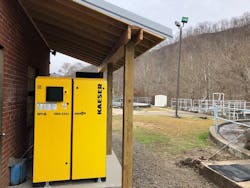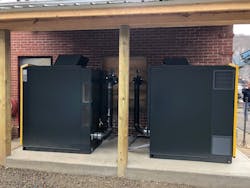Michael Camber is marketing services manager for Kaeser Compressors Inc. Stephen Horne is product manager of blowers for Kaeser Compressors Inc. Travis Snead is district manager for Kaeser Compressors Inc. Camber can be reached at [email protected]. Horne can be reached at [email protected]. And Snead can be reached at [email protected].
Chapmanville Water Department in Logan County, W.Va., provides the water distribution and wastewater treatment services in the town of Chapmanville, which has a population of 1,200. It wastewater plant processes about 400,000 gal per day (gpd). The town planned a major upgrade for 2019 and 2020, including the replacement of three 40 hp multi-stage centrifugal blowers commissioned 25 years earlier.
At the beginning of 2018, one of these was no longer in service. Chapmanville planners hoped to limp along on the two remaining blowers, but in the spring of 2018, they lost another one. Down to one blower, the planners knew they could not wait for the planned upgrade, and the department had to do something.
Plans for the new plant included replacing all three 40 hp centrifugal blowers with two 60 hp blowers of the same type. The water department had estimated that it could supply both basins with air from one new blower, with 100% back up. However, this did not solve its immediate problem. The department received estimates to fix the blowers, but at $25,000 each this did not seem like a wise choice for a short-term solution.
Integral to the project was Chapmanville’s service partner, C2G Engineering of Huntington, W.Va., which specializes in automation and electrical engineering, including full system integration. Ralph Rinehart of C2G suggested the department explore upgrading the blower s in advance of the plant-wide rehab. Further, he suggested alternatives to the traditional centrifugal blower solution. The engineering firm contacted Travis Snead of Kaeser Compressors, a compressor and blower manufacturer with a U.S. headquarters in Fredericksburg, Va.
Kaeser offered to perform an air demand analysis (ADA) to baseline current air use and power consumption, and provide a better understanding of the situation overall for decision makers. The company first reviewed the original specifications to find the original design conditions for the existing system. Comparing the performance parameters for the 1993 vintage blowers to performance specifications for new rotary screw type blowers provided the first hint that Chapmanville might achieve significant electrical savings with a different approach.
C2G Engineering also brought in a representative from Appalachian Power to discuss potential efficiency rebates for new equipment purchases. Appalachian Power offered a one-time lump sum payment of $0.07 for each kWh eliminated in the first year of operation. This made the project more attractive, but a lot depended on the value of the power savings. The incentive was tied to several requirements:
- Energy consumption measurements of the existing and new systems;
- Should be based on post-installation energy measurements;
- Must show a payback of seven years or less; and
- Installation and commissioning would complete during the current calendar year (2018).
Air Demand Analysis
The first action was to measure current power consumption in order to quantify the actual savings and provide a basis to estimate the potential incentive payment. The ADA measurement plan included data logging the operation of the existing blower and measuring the power consumption. Kaeser’s protocol requires measuring actual kilowatts versus tracking amps and estimating power. The measurement plan for the existing system also included a flow meter to confirm air volume delivered, a pressure sensor after the blower discharge, and temperature sensors to track blower discharge and
ambient temperature.
With this performance data, Kaeser estimated that the town could save roughly $14,000 per year in power costs by installing rotary screw blowers controlled by variable speed drives. With the local utility’s incentive they could receive an additional $14,000 once the power consumption was verified.
Possible Solutions
Using the data collected during the ADA, Kaeser ran scenarios on two equipment solutions. In both cases, the 40 hp centrifugal units were replaced with 30 hp screw blowers, offering more flow than the existing 40 hp units. One option offered fixed speed blowers and the other offered variable speed blowers.
Improved Control of Dissolved Oxygen (DO). The existing fixed speed system had been putting out full flow year-round with no DO controls. As it turned out, the DO levels often were higher than necessary, indicating that much of the air production and energy to make it was wasted. This situation is common among treatment plants throughout the U.S., where operators must manually sample DO and manually throttle the flow to manage the DO in the basin.
Kaeser and C2G proposed adding dedicated DO sensors to the basins to provide feedback control for the blowers. Both options offered the opportunity to integrate automated control of DO; however, the variable speed option would provide DO control via blower speed regulation. The blower speed varies in response to a 4-20mA signal from DO sensors according to the biological needs of the basin. Though the variable speed solution cost more up front, the potential energy savings are higher.
Running the Numbers
The town chose the second option, with a total project cost of $112,000. This included the blower equipment, sensors and contracted plumbing, welding and electrical services. Chapmanville had secured approval and funding for a major plant upgrade for 2019 to 2020, but this would not cover the advanced purchase of blowers. Ultimately, Chapmanville opted for traditional capital equipment financing, and much of the cost would be underwritten by significant annual power savings plus the upfront incentive payment.
Town officials considered both three and five-year financing, with monthly payments of $2,616 and $1,663. Factoring in the monthly energy savings knocked the “out of pocket” cost to $1,419 and $466. This meant that after 60 months, they would only pay $27,947.40 for $100,000 in new equipment, even without factoring in the utility incentive. After noting this, the town approved the project.
The Incentive Kicker
Appalachian Power required post-installation data to confirm the savings for the incentive payment. This was accomplished without the need for another ADA since the Sigma Control 2 on each of the two new DBS rotary screw blowers provided the data needed. Pressure, run time, motor speed, drive data and DO levels were tracked and stored on an SD card. This data demonstrated the value of the variable speed unit and DO regulation while easily allowing for a power consumption evaluation.
After assessing the data, Appalachian Power concluded that Chapmanville would qualify for a one-time incentive payment of $18,298. This was 30% more savings than the initial estimation. With annual savings over $18,000 and an equal up-front incentive payment, the payback for the $112,000 project was a little more than five years–well under the seven year requirement for the utility company. Looking longer term, energy savings added up to nearly $366,000 for a conservative equipment life expectancy of 20 years.
Summary
Chapmanville turned an impending crisis into a project that yielded financial and operational gains. In the end, it replaced 40 hp with 30 hp blowers instead of increasing to 60 hp, and the department adopted modern controls and a bit of automation that offer measurable improvements. They leveraged newer blower technology, the opportunity to perform an accurate flow and power consumption assessment, and the availability of utility incentives to deliver value to the local tax payers through lower energy bills and better wastewater treatment.


